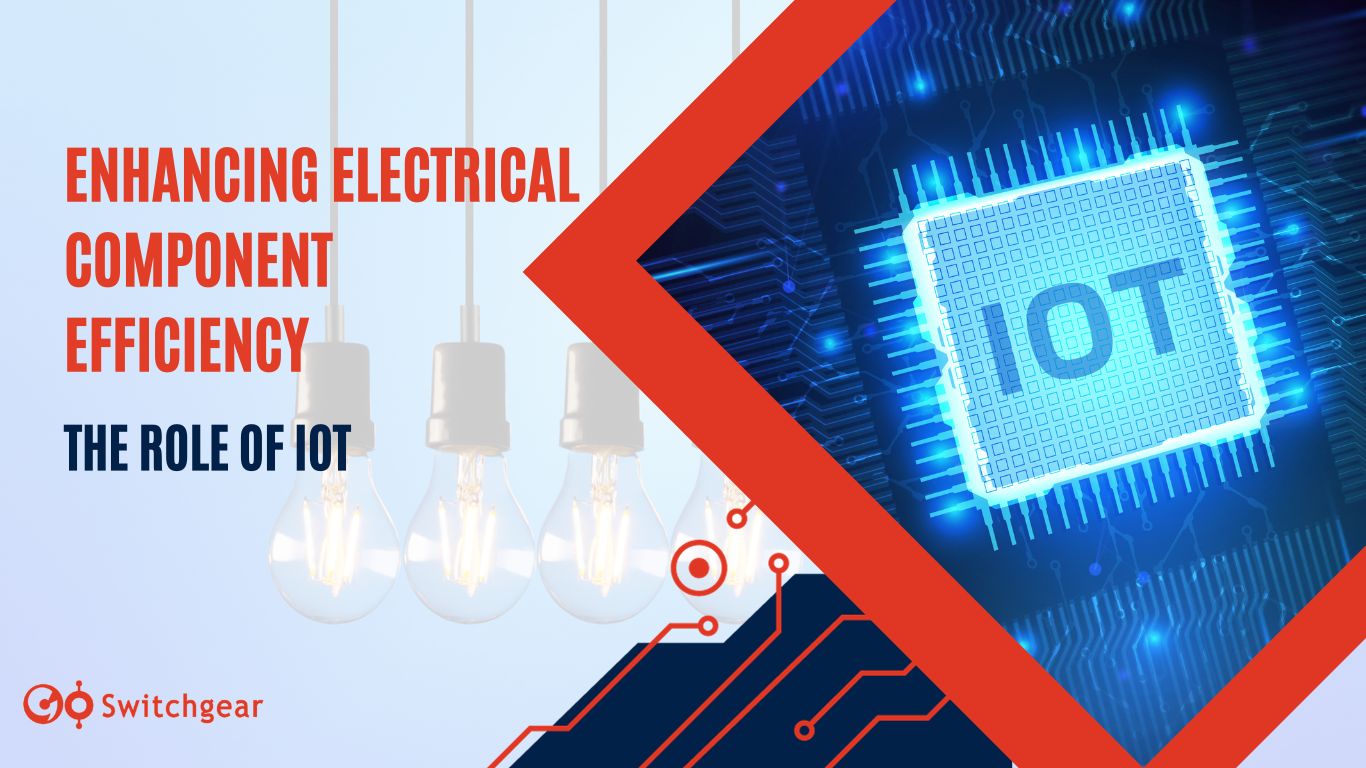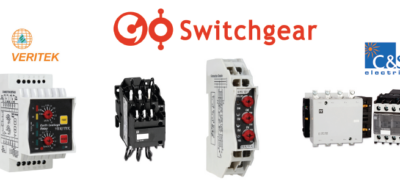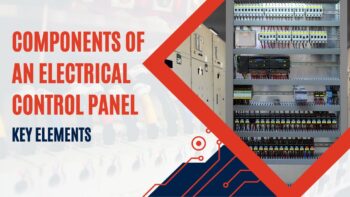The Role of IoT in Enhancing Electrical Component Efficiency
Introduction
The integration of the Internet of Things (IoT) in electrical components is transforming how energy is managed, monitored, and optimized across industries. As businesses and households demand greater sustainability, efficiency, and cost savings, IoT has emerged as a powerful tool to drive innovation in electrical engineering. By leveraging IoT energy management systems, electrical components such as circuit breakers, transformers, relays, and switchgear can operate more efficiently, reducing waste and extending equipment lifespan.
This article explores the growing role of IoT electrical efficiency solutions, the practical benefits of IoT energy monitoring, and how industries can use these technologies to improve performance, cut costs, and promote sustainable energy use. We’ll also discuss challenges in adoption, highlight real-world examples, and show why working with a trusted partner like GoSwitchgear is critical for achieving measurable results.
1. Understanding IoT in Electrical Components

IoT in electrical components refers to the integration of smart sensors, data analytics, and communication technologies into devices such as:
- Circuit breakers for fault detection and predictive maintenance.
- Transformers for load monitoring and efficiency optimization.
- Switchgear systems for real-time system protection and coordination.
- Relays and meters for precise IoT energy monitoring.
By embedding intelligence into these devices, electrical systems can automatically collect data, analyze performance, and even predict failures before they occur. This creates a smarter, safer, and more energy-efficient electrical infrastructure.
2. The Connection Between IoT and Energy Efficiency
The relationship between IoT and energy is profound. Traditional electrical systems often rely on reactive maintenance and scheduled inspections. In contrast, IoT-enabled systems leverage real-time energy monitoring to identify inefficiencies as they occur.
Key benefits include:
- IoT electrical efficiency: reducing wasted energy by 10–20%.
- IoT energy management: optimizing load distribution to avoid peak demand charges.
- Predictive maintenance: decreasing downtime and extending equipment life by 15–25%.
When combined, these benefits help businesses achieve significant operational savings while supporting sustainability goals.
3. How IoT Enables Smarter Electrical Systems
IoT creates a connected ecosystem in which every electrical component communicates data back to a central system. This enables:
- Automation: Lights, motors, and HVAC systems automatically adjust based on usage patterns.
- Fault Detection: Smart relays identify irregularities in current flow instantly.
- Data Insights: Analytics platforms help managers make data-driven energy decisions.
- Remote Monitoring: Operators gain visibility into systems across multiple sites.
This holistic approach forms the foundation of IoT energy solutions, ensuring maximum efficiency and reliability.
4. Key Applications of IoT in Electrical Engineering
Home Automation
In residential settings, IoT for energy empowers homeowners to monitor and control:
- Smart circuit breakers that shut off power during overloads.
- Energy-efficient lighting systems that dim automatically.
- IoT-enabled meters that track household energy use in real-time.
Industrial Operations
Factories and plants benefit enormously from IoT in electrical engineering:
- Industrial IoT gateways connect machinery to energy monitoring platforms.
- Transformers and switchgear monitor loads to prevent outages.
- Relays enable predictive maintenance, cutting downtime by up to 20%.
Smart Grids
For utilities, IoT ensures efficient distribution of energy through:
- Smart transformers for real-time load balancing.
- IoT-enabled grid monitoring that prevents blackouts.
- Demand-response systems that reduce peak energy stress.
By specifying these electrical components, IoT’s transformative role becomes clear across every sector.
5. Enhancing Electrical Component Efficiency with Smart Monitoring and IoT Control
Smart monitoring enables organizations to:
- Reduce energy consumption by up to 15% through real-time usage adjustments.
- Lower maintenance costs by 20% by predicting failures before they occur.
- Improve system uptime by 25%, ensuring a reliable power supply.
For example, a large manufacturing plant using IoT-enabled relays and transformers reduced its monthly energy bill by $25,000, thanks to precise IoT energy monitoring and automation.
6. The Power of Remote Access in IoT Systems
One of the biggest advantages is the power or efficiency of remote access in IoT. Managers can monitor and control equipment from anywhere, using mobile apps or dashboards.
Benefits include:
- Faster response times to outages.
- Centralized monitoring across multiple facilities.
- Improved worker safety by reducing manual inspections.
This level of control transforms traditional electrical systems into proactive, self-optimizing networks.
7. Case Studies: Quantifiable Energy Savings Through IoT
- Commercial Building: IoT-controlled HVAC systems reduced energy use by 18% annually.
- Data Centers: Smart power distribution reduced cooling energy costs by 25%.
- Utilities: IoT-enabled smart grids cut outage times by 30%.
These measurable results prove that IoT energy solutions deliver real-world benefits in diverse environments.
8. Industrial IoT Gateways and Their Role in Energy Management
Understanding what are IoT gateways electrical supply store is key to optimizing energy systems. Gateways act as communication bridges between IoT-enabled devices and the central network.
In industrial settings:
- Industrial IoT gateways ensure seamless communication between sensors, relays, and cloud platforms.
- They enable energy management in IoT by aggregating data and sending it for analysis.
- They provide secure connectivity for remote monitoring and control.
Without gateways, IoT energy management at scale would not be possible.
9. Challenges in IoT Integration for Electrical Systems
While promising, IoT adoption faces challenges:
- Interoperability: Devices from different vendors may not communicate effectively.
- Legacy System Integration: Many electrical infrastructures are outdated.
- Data Overload: Large volumes of sensor data require advanced analytics to process.
- Cybersecurity Risks: Electrical systems must be safeguarded against cyber threats.
Addressing these challenges ensures successful deployment of IoT in electrical engineering.
10. The Future of IoT Energy Solutions

The future of internet of things and energy lies in:
- AI-driven energy analytics for smarter predictions.
- Blockchain-based energy trading for decentralized power sharing.
- Ultra-low-power sensors for wider adoption.
- Integration with renewable energy sources for sustainability.
This evolution will strengthen IoT energy solutions, enabling more efficient, resilient, and eco-friendly power systems worldwide.
FAQs
Q1: How does IoT improve electrical efficiency?
IoT electrical efficiency is achieved by monitoring, automating, and optimizing energy usage, reducing waste by 10–20%.
Q2: Which electrical components benefit most from IoT integration?
Circuit breakers, transformers, relays, and switchgear are significantly enhanced by IoT.
Q3: What role do IoT gateways play in energy systems?
Industrial IoT gateways collect and transmit data, enabling real-time IoT energy monitoring and analytics.
Q4: How does IoT support energy management?
Through load balancing, predictive maintenance, and remote access, IoT energy management improves efficiency and cuts costs.
Q5: Can IoT be used for renewable energy?
Yes, IoT and energy systems integrate solar, wind, and battery storage for smarter IoT energy solutions.
Conclusion and Next Steps
The integration of IoT in electrical components is no longer optional—it’s essential for businesses, homes, and utilities aiming to reduce costs, improve reliability, and achieve sustainability goals. From IoT energy monitoring in smart homes to industrial IoT gateways powering entire factories, the possibilities are limitless.
At GoSwitchgear, we specialize in delivering cutting-edge solutions that combine the latest in IoT technology with reliable electrical components. Whether you need equipment from a trusted electrical supply store or prefer the convenience of an online electrical supply store, we have the expertise and resources to help.
Contact GoSwitchgear today to learn how IoT energy solutions can optimize your electrical systems and position you for a smarter, more sustainable future.










Leave a Reply